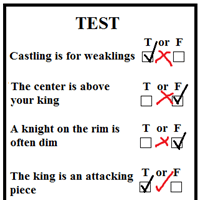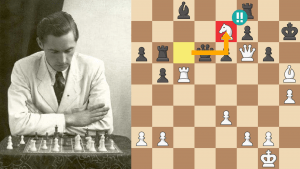
Test Your Chess Understanding, Part 1
Usually an article discusses a particular player, or tactics, or some positional concept. When I teach tactical motifs, you know that all the puzzles are going to be about tactics. If I am discussing a particular idea concerning a pawn structure, then you know exactly what you need to be looking for in any accompanying puzzles. However, in real life you will often completely miss some epic combination or some positional coup de grâce since anything and everything is possible in any given position.
This week I’ll be offering something a bit different. Instead of certainty, I’ll give you uncertainty. And instead of looking for that one special move in a puzzle, I want you to answer a myriad of questions about every puzzle position. Ideally you will write down your answers and thoughts for all seven puzzles, and only then look at the answers. But, if you don’t have the time for such serious chess study, you can just go right to the answers, all of which are filled with instructive tidbits. You’ll learn something either way!
PUZZLES
PUZZLE 1:
White, who is up a piece for a pawn, has to be winning this position, though Black's central pawns will keep the wolves at bay for a while. However, having a winning position and winning a winning position are often two different things.
White’s e4-knight is attacked and has to move. But where? And Why? In the game White played 13.Neg5. Was this best? If not, what was better? After 13.Neg5 Black played 13...e4. Was this correct? If it was correct, can you explain why? If not, why not?
PUZZLE 2:
After the moves 1.e4 e6 2.d4 d5 3.Nc3 Nf6 4.e5 Nfd7 5.f4 c5 6.Nf3 Nc6 7.Be3 cxd4 8.Nxd4 Bc5 9.Nxc6 bxc6 10.Bxc5 Nxc5 11.b4 we get the following position:
Was 11.b4 a good move? Whether it’s good or bad, Black’s knight has to move.
If Black wants to avoid hanging a piece, he only has 4 choices (11...Na6, 11...Nb7, 11...Nd7, and 11...Ne4). Which is best?
PUZZLE 3:
This position is quite unpleasant for Black since White has more kingside and central space and, if his central pawns become mobilized, Black’s position might implode. Threats like h2-h4-h5-h6 and Bf3 followed by d4-d5 are in the air, and it’s hard to see how Black can deal with them. What would you do?
PUZZLE 4:
Black to move played 14...Bd7. Is that a logical move? Be it good or bad, how should White respond?
PUZZLE 5:
What are White’s advantages? How should he try and take advantage of them?
PUZZLE 6:
After 16...0-0-0 White has an edge, but nothing earthshaking. Nevertheless, chess is about putting your opponent under maximum pressure, and making maximum use of whatever you happen to have. Find a way to do this.
PUZZLE 7:
Not done solving puzzles? Tactics Trainer is waiting!
QUESTIONS:
- White is clearly doing well on the kingside, but Black intends to get counterplay on the queenside (it’s only fair!). Should White play take on b5 (27.cxb5), block with 27.a4, or just ignore Black’s nonsense and continue with his kingside play?
- White has many ideas in this position, but one very long-range positional plan stands out. Take a guess at what that might be.
ANSWERS TO THE PUZZLES
PUZZLE 1
QUESTION: White, who is a piece for a pawn up, has to be winning this position though his center pawns will keep the wolves at bay for a while. However, having a winning position and winning a winning position are often two different things.
White’s e4-knight is attacked and it has to move. But where? And Why? In the game White played 13.Neg5. Was this best? If not, what was better? After 13.Neg5 Black played 13...e4. Was this correct? If it was correct, can you explain why? If not, why?
ANSWER: In chess it’s very important to make sure all your pieces are working together in a fluid manner. With 13.Neg5 the knight will end up “offsides” and become ineffective for quite a while. After 12...d5 White needs to take a long think and do his best to make Black’s center pawns targets. Important: It’s not enough to move the knight to safety, you also have to move it to a place where it will force a concession from Black's central pawns.
Once you understand that, then 13.Nc3! is clearly the way to go since 13...Rd8? 14.Nxe5! is resignable for Black (14...Qxe5 15.Rhe1). Thus 13...e4 is forced: 14.Qd2 and, since he can’t take on f3 due to his king being in the middle (14...exf3 15.Rhe1), White has won the d4-square (and turned Black’s center into a static weakness instead of a dynamic wall).
In the game White played 13.Neg5? when 13...f6 14.Nh3 0-0 when Black’s center is suddenly solid and White’s h3-Knight sucks. Also notice that the f3-knight isn’t exactly dominating the board.
LESSON 1: Winning a won game is tough for everyone, and the answer to this conundrum varies from one position to another. In the present case, White was up material and if he consolidated then the win would only be a matter of time. Consolidating doesn’t mean hiding on the first two ranks and guarding everything in a passive stupor. Yes, make sure your gains are safe and sound, but then take a serious look at the positional and tactical landscape too. In our example White had three initial goals: 1) Don’t give your stuff away! 2) Turn the enemy center into Swiss cheese (this led to the creation of a hole on d4). 3) Make use of Black’s central king, which allowed a possible tactic based on Nxe5.
Once you accomplish the weakening of Black’s center (making it happen thanks to the tactical Nxe5 possibility), suddenly good things seem to sprout up all by themselves: The enemy pawns aren’t mobile. The enemy Bishop is a tall pawn. White’s d4-knight rules the board.
PUZZLE 2
QUESTION: After the moves 1.e4 e6 2.d4 d5 3.Nc3 Nf6 4.e5 Nfd7 5.f4 c5 6.Nf3 Nc6 7.Be3 cxd4 8.Nxd4 Bc5 9.Nxc6 bxc6 10.Bxc5 Nxc5 11.b4 we get the following position:
Was 11.b4 a good move? Whether it’s good or bad, Black’s knight has to move.
If Black wants to avoid hanging a piece, he only has 4 choices (11...Na6, 11...Nb7, 11...Nd7, and 11...Ne4). Which is best?
ANSWER: 11.b4 was a poor move that weakens White’s queenside and leaves a hole on c4. Don’t attack a piece unless there’s a good reason to do so.
11...Nd7 is by far the best move. It not only allows the knight to head for the newly created c4-hole in some lines, but it also puts pressure on e5, thus making the common ...0-0 followed by ...f6 sequence far more effective.
11...Na6 12.a3 leaves the Black knight offsides, while 11...Nb7 stymies Black’s own piece (since it can’t move to a5, c5, or d6). 11...Ne4 12.Nxe4 dxe4 13.Qxd8+ Kxd8 14.Kf2 (heading for e3) leaves Black with a damaged pawn structure and a bad bishop vs. White’s good bishop.
LESSON 2: Don’t just move a piece to any square. Instead, make sure the piece has a future on the square you are moving it too, and that it works with the rest of its army.
PUZZLE 3
QUESTION: This position is quite unpleasant for Black since White has more kingside and central space and if his central pawns become mobilized Black’s position might implode. Threats like h2-h4-h5-h6 and Bf3 followed by d4-d5 are in the air and it’s hard to see how Black can deal with them. What would you do?
ANSWER:

LESSON 3: Positional Exchange sacrifices are an important part of chess. In this game Black solved his problems by giving up an Exchange for a firm blockage of White’s central majority, a mobile queenside pawn majority, a strong light-squared bishop, and a monster knight that can happily live on the d5-hole. That’s a lot of stuff for a measly Exchange!
PUZZLE 4
QUESTION: Black to move played 14...Bd7. Is that a logical move? Be it good or bad, how should White respond?
ANSWER: 14...Bd7?? is actually a serious mistake! Instead 14...c5, cracking the queenside and gaining space, would leave Black with an excellent position.
After 14...Bd7 White can take over the game with 15.Na4! Qc7 16.Ba6! when Black is on the brink of being dead lost. After chopping off the knight, White will lay claim to the c5-square, and he’ll also end up with a winning knight vs. bishop scenario! Here’s an example: 16...Rae8 (As horrible as it is, Black should play 16...Nd8 and hope for the best.) 17.Bxb7! (Creating a crushing knight vs. bad bishop imbalance.) 17...Qxb7 18.Nc5 Qc7 19.0-0 f6 20.Rae1 a5 (20...fxe5 21.Rxe5) 21.c3 Bc8 22.Qd4 and all of White’s pieces are superior to their counterparts.
LESSON 4: Amateurs often over-prepare. However, it’s usually better to grab the opportunity to free yourself with a pawn break while it’s still possible. The key point of this example, though, is that one never knows when a bad minor piece exchange can cook your goose. Training yourself to always be on the lookout for ways to create a superior minor piece is one of the most important skills in chess.
PUZZLE 5
QUESTION: What are White’s advantages and how should he try and take advantage of them?
ANSWER: Though White enjoys a superior pawn structure, the most pronounced imbalance is White’s big lead in development and the fact that Black’s king is still in the center while White’s king is safely tucked away on the kingside.
LESSON 5: You can’t find a way to punish your opponent if you aren’t aware of his illness. In general, a lead in development plus an uncastled enemy king screams for dynamic, combinative play since a quiet approach would allow the opponent time to castle and develop.
PUZZLE 6
QUESTION: After 1.d4 d5 2.c4 c6 3.Nc3 Nf6 4.e3 e6 5.Nf3 Nbd7 6.Qc2 Bd6 7.e4 Nxe4 8.Nxe4 dxe4 9.Qxe4 c5 10.Bg5 Qa5+ 11.Bd2 Qc7 12.0-0-0 Nf6 13.Qh4 cxd4 14.Nxd4 Bd7 15.Kb1 a6 16.Bd3 0-0-0 White has an edge, but nothing earthshaking. Nevertheless, chess is about putting your opponent under maximum pressure, and making maximum use of whatever you happen to have. Find a way to do this.
ANSWER:
LESSON 6: You've got to use what you have, but if you don’t know what you have, you won’t be able to use it! That’s why the concept of imbalances is so important for the amateur player. The combination of White’s queenside majority and Black’s slightly vulnerable king birthed 17.c5.
PUZZLE 7
QUESTIONS:
- White is clearly doing well on the kingside, but Black intends to get counterplay on the queenside (it’s only fair!). Should White take on b5 (27.cxb5), block with 27.a4, or just ignore Black’s nonsense and continue with his kingside play?
- White has many ideas in this position, but one very long-range positional plan stands out. Take a guess at what that might be.
In his wonderful book, My Best Games (Published by RHM Press in 1978), Karpov had this to say about our initial position:
“Everything, or almost everything, has been accomplished. All that remains is to defend c4 and e4 so as to exchange light-square bishops, after which my opponent will not be able to defend all the weak points in his position. This is White’s general strategic plan. But to carry it out, he must undergo certain difficulties and make his way through a multitude of tactical subtleties.”

ANSWERS:
- First off, 27.cxb5? is absolutely horrible! After 27...Nxf3+ 28.Qxf3 Nxb5 White has kindly turned the “dead” knight on c7 into a monster that’s about to leap into d4. Since Black threatens to open two files on the queenside with ...a5-a4, White played 27.a4! which only allows Black to open one file. Moreover, though Black will gain access to the hole on b4, it turns out to be useless, as we’ll see in the game.
- White’s long-term plan is to exchange light-squared bishops since Black’s light-squared bishop can turn an eye on important squares like e6, g6, f5, and g4, while White’s light-squared bishop is a purely defensive piece, more or less trapped behind it’s wall of pawns.
LESSONS 7: Many things can be learned from this game, but the two I picked out are:
- If you intend to successful defend an area that your opponent is ripping open and will invade, don’t allow him to create too many roads into your territory. 27.a4 allows one road, while allowing ...a5-a4 creates two.
- Recognizing that one minor pieces is more important than another is a key chess skill. If that enemy piece is not only better than yours but is also holding body and limb together, moving heaven and earth to exchange those bishops, even if it takes a long time to accomplish, is often a worthwhile endeavor!
I will add that the Exchange sacrifice by 31...Rb4! (discussed in the notes) is something to ponder. It’s a very important concept.
BONUS GAME
To ram home the point about positional Exchange sacrifices, let’s take a look at the following position (the queenside structure will remind you of the Karpov game):
In the position below, White has a lot of things going his way: central space, pressure against a5, and the ability to expand in the center with an eventual e2-e4, f2-f4, and e4-e5. On the other side of the pond, Black has no active play, his a6-bishop is hitting a wall, and a positive plan for Black is hard to find. Instead of waiting around and hoping something nice happens by itself, Black takes matters into his own hands and turns the whole position on its head.
RELATED STUDY MATERIAL
- Read Silman's article You Have It, He Doesn’t! Part 1;
- Let GM Melikset Khachiyan show you the brilliance of the Exchange sacrifice in Becoming an Expert - Part 3: Kasparov's Rxc3!;
- Tear apart your opponent's pawn structure in Chess Mentor;
- Maintain your tactical readiness in our Tactics Trainer;
- Looking for articles with deeper analysis? Try our magazine: The Master's Bulletin.






